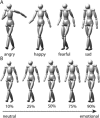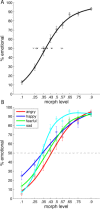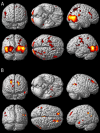Common neural correlates of emotion perception in humans
- PMID: 26219630
- PMCID: PMC6869080
- DOI: 10.1002/hbm.22910
Common neural correlates of emotion perception in humans
Abstract
Whether neuroimaging findings support discriminable neural correlates of emotion categories is a longstanding controversy. Two recent meta-analyses arrived at opposite conclusions, with one supporting (Vytal and Hamann []: J Cogn Neurosci 22:2864-2885) and the other opposing this proposition (Lindquist et al. []: Behav Brain Sci 35:121-143). To obtain direct evidence regarding this issue, we compared activations for four emotions within a single fMRI design. Angry, happy, fearful, sad and neutral stimuli were presented as dynamic body expressions. In addition, observers categorized motion morphs between neutral and emotional stimuli in a behavioral experiment to determine their relative sensitivities. Brain-behavior correlations revealed a large brain network that was identical for all four tested emotions. This network consisted predominantly of regions located within the default mode network and the salience network. Despite showing brain-behavior correlations for all emotions, muli-voxel pattern analyses indicated that several nodes of this emotion general network contained information capable of discriminating between individual emotions. However, significant discrimination was not limited to the emotional network, but was also observed in several regions within the action observation network. Taken together, our results favor the position that one common emotional brain network supports the visual processing and discrimination of emotional stimuli.
Keywords: action observation; bodies; emotion; fMRI; human; perception; visual.
© 2015 Wiley Periodicals, Inc.
Figures








Similar articles
-
Emotions in motion: dynamic compared to static facial expressions of disgust and happiness reveal more widespread emotion-specific activations.Brain Res. 2009 Aug 11;1284:100-15. doi: 10.1016/j.brainres.2009.05.075. Epub 2009 Jun 6. Brain Res. 2009. PMID: 19501062
-
Clear signals or mixed messages: inter-individual emotion congruency modulates brain activity underlying affective body perception.Soc Cogn Affect Neurosci. 2016 Aug;11(8):1299-309. doi: 10.1093/scan/nsw039. Epub 2016 Mar 28. Soc Cogn Affect Neurosci. 2016. PMID: 27025242 Free PMC article.
-
Dissociable neural pathways are involved in the recognition of emotion in static and dynamic facial expressions.Neuroimage. 2003 Jan;18(1):156-68. doi: 10.1006/nimg.2002.1323. Neuroimage. 2003. PMID: 12507452
-
The perception of emotion in body expressions.Wiley Interdiscip Rev Cogn Sci. 2015 Mar-Apr;6(2):149-158. doi: 10.1002/wcs.1335. Epub 2014 Dec 22. Wiley Interdiscip Rev Cogn Sci. 2015. PMID: 26263069 Review.
-
Distributed and interactive brain mechanisms during emotion face perception: evidence from functional neuroimaging.Neuropsychologia. 2007 Jan 7;45(1):174-94. doi: 10.1016/j.neuropsychologia.2006.06.003. Epub 2006 Jul 18. Neuropsychologia. 2007. PMID: 16854439 Review.
Cited by
-
Elevated Neutrophil-to-Lymphocyte Ratio Predicts Depression After Intracerebral Hemorrhage.Neuropsychiatr Dis Treat. 2020 Sep 21;16:2153-2159. doi: 10.2147/NDT.S269210. eCollection 2020. Neuropsychiatr Dis Treat. 2020. PMID: 33061386 Free PMC article.
-
The Evolution of the Optimization of Cognitive and Social Functions in the Cerebellum and Thereby the Rise of Homo sapiens Through Cumulative Culture.Cerebellum. 2024 Oct;23(5):1981-1992. doi: 10.1007/s12311-024-01692-z. Epub 2024 Apr 27. Cerebellum. 2024. PMID: 38676835 Review.
-
Anterior Temporal Lobectomy Impairs Neural Classification of Body Emotions in Right Superior Temporal Sulcus and Reduces Emotional Enhancement in Distributed Brain Areas without Affecting Behavioral Classification.J Neurosci. 2018 Oct 24;38(43):9263-9274. doi: 10.1523/JNEUROSCI.0634-18.2018. Epub 2018 Sep 18. J Neurosci. 2018. PMID: 30228228 Free PMC article.
-
Risk Factors for Post-stroke Depression: A Meta-analysis.Front Aging Neurosci. 2017 Jul 11;9:218. doi: 10.3389/fnagi.2017.00218. eCollection 2017. Front Aging Neurosci. 2017. PMID: 28744213 Free PMC article. Review.
-
Neural representations of the amount and the delay time of reward in intertemporal decision making.Hum Brain Mapp. 2021 Aug 1;42(11):3450-3469. doi: 10.1002/hbm.25445. Epub 2021 May 2. Hum Brain Mapp. 2021. PMID: 33934449 Free PMC article.
References
-
- Atkinson AP, Dittrich WH, Gemmell AJ, Young AW (2004): Emotion perception from dynamic and static body expressions in point‐light and full‐light displays. Perception 33:717–746. - PubMed
-
- Barrett LF (2006): Solving the emotion paradox: Categorization and the experience of emotion. Pers Soc Psychol Rev 10:20–46. - PubMed
-
- Blair RJ, Morris JS, Frith CD, Perrett DI, Dolan RJ (1999): Dissociable neural responses to facial expressions of sadness and anger. Brain 122 (Part 5):883–893. - PubMed
-
- Blakemore SJ, Decety J (2001): From the perception of action to the understanding of intention. Nat Rev Neurosci 2:561–567. - PubMed
Publication types
MeSH terms
LinkOut - more resources
Full Text Sources
Other Literature Sources
Medical

